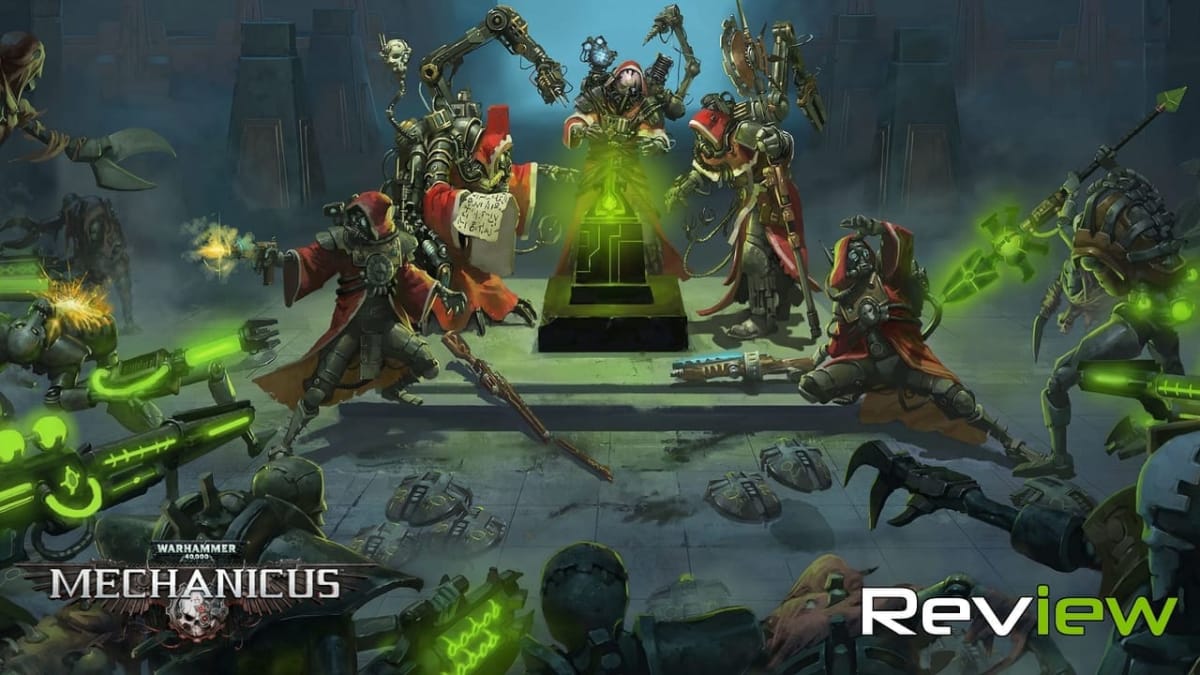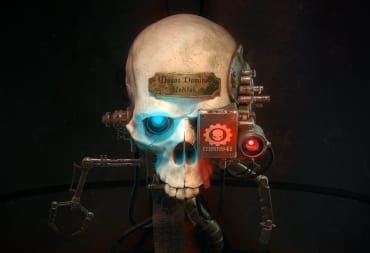In the grim darkness of the far future, there are no men of science, only priests serving the immortal machine. To unlock lost technology and achieve spiritual purity, these tech-priests forfeit their humanity, replacing flesh with wire and steel. They are the Adeptus Mechanicus, guardians of mankind’s legacy, and they finally have their own game.
In Warhammer 40,000: Mechanicus, you play Magos Dominus Faustinus, a high priest of the machine cult whose flagship has just entered orbit over a long-abandoned planet. Your scouts quickly discover the planet’s crust is riddled with ancient alien catacombs belonging to the Necron, a robotic race of skeletal warriors. Your arrival triggers their awakening. Now you must wage war on their home turf, controlling your customizable tech-priests in dungeon-crawling, turn-based combat to ensure the Necron are returned to their sarcophagi. Basically, it’s space archeologists vs. space mummies.
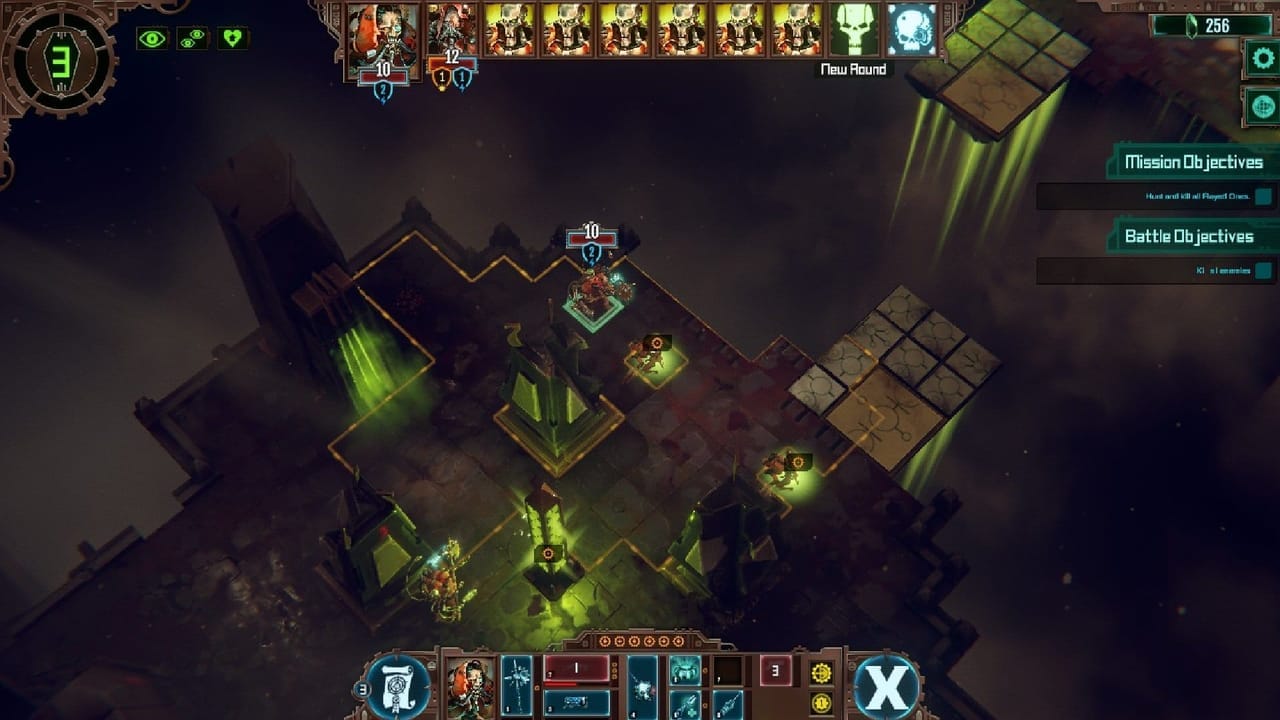
Turn-based combat is the artificial heart of Mechanicus, and it’s really, really good. The style is unique, and there are a lot of interesting mechanics. It may be the most gripping turn-based game I’ve ever played. I want to focus on what makes the combat unique. It makes up the majority of gameplay and all the elements come together just right.
The central element of Mechanicus' combat is a currency system called “cognition.” In-game, this is described as your tech-priests gaining insight into how the Necron react to their attacks. Most weapons use cognition, but it can also be used to double your movement speed. Here’s the clincher: while each weapon can only be used once per turn, you can use them all and keep moving so long as you have cognition.
To collect this combat currency you can use “Servo-skulls,” essentially multi-purpose mobile scanners. Aside from collecting cognition from defeated Necrons and other alien artifacts, the Servo-skulls can scan enemies directly. This reveals a Necron’s armor type (energy or physical) and HP. Tech-priest upgrades give Servo-skulls additional abilities such as damaging enemies and buffing your allies. There’s a surprising amount of strategy in using these things because they can only be used every other turn.
Also notable is that every weapon in Mechanicus has a unique rage meter called “Machine Spirit.” Basically, every weapon has a charge meter. When fully charged, the next attack increases damage and activates a special ability. At one point I ran up to a Necron with 10HP and 3 physical armor. My power axe's 9-11 damage wasn't going to cut it. Because of the enemy's armor bonus, any attack I made with my axe was going to take a -3 damage penalty. So, I activated an ability that automatically charged Machine Spirt on all weapons. Suddenly my next attack with the axe would do 11-13 damage and its special ability would simultaniously remove 2 points of enemy armor. That poor Necron didn't stand a chance.
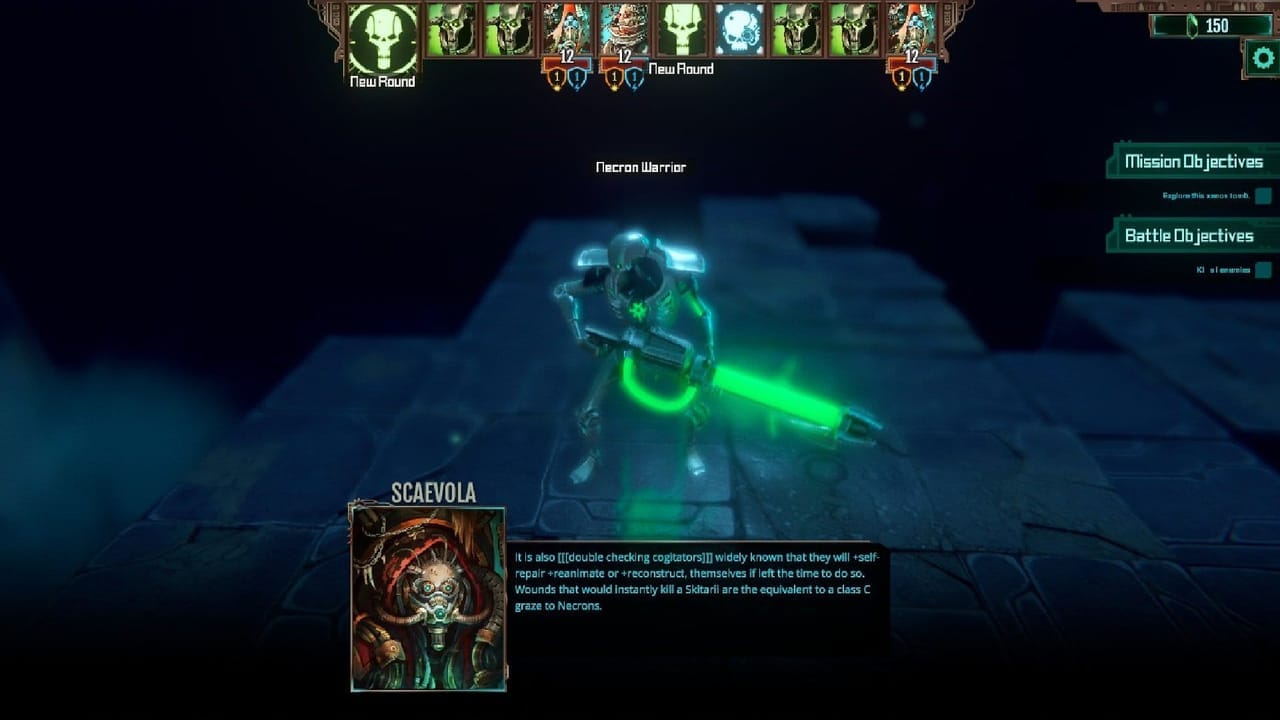
Finally, there’s the Necron themselves. Warhammer 40,000 fans will find the game mechanics to be a faithful recreation of the lore. When you bring a Necron to 0 HP, they don’t die. You have three turns to deal an additional point of damage before they return to combat at full health. Additionally, each Necron unit has a very specialized role. For example, the basic Necron warrior is incapable of melee, meaning they need to move (and open themselves to an opportunity attack) if a tech-priest is within melee range. That’s great enemy design; it feels like playing a game of battle chess where you have three queens.
There’s also a timed element to battle. Each tomb has a timer to represent Necron awakening. This timer ticks up every time you move to a new room or finish a round of combat. First, Necrons are merely aware of your presence. Then, each battle has additional Necrons. At Level 3, the 0 HP repair timer is a turn shorter. Levels higher than 3 get really hectic. If you’re not careful, battles become a war of attrition as the enemy gets stronger while your tech-priests burn out.
Your tech-priests have a lot of customization options. Thankfully, the upgrade process avoids grinding by design. As you explore each tomb, you gain an upgrade currency called blackstone. Between missions, you can use that currency to upgrade your tech-priests. This means you don’t have to grind by sending low-level tech-priests into difficult dungeons.
While upgrading tech-priests, I couldn't ignore the fact that the UI could use some work. For example, each weapon uses a different amount of cognition, as much as 4pts, but you can’t see your maximum cognition in the character screen. Similarly, you while you can equip your tech-priests with augments that increase their movement speed, you can’t see their new max speed in the character creation screen. Ultimately these aren’t major issues, but it’d be an easy quality of life fix in a future patch.
Every level-up does two things. You choose a perk from one of the skill trees and you get an augmentation slot.
The perk trees are designed around the different styles of gameplay. My favorite is the "Lexmechanic," tech-priests who focus on gathering cognition. At first, your tech-priests gain 1 cognition at the start of their turn. Already you're at a huge advantage. By the end of the skill tree, all my tech-priests were gaining cognition for every single kill and another point every time they were shot at. My plasma beams cost 4 cognition points to fire, but I was killing so many Necrons that I was gaining 6 cognition per attack. In addition, I could collect an additional 6 cognition just by walking past each Necron's body. Since you can move as long as you have cognition, your Lexmechanics become designated marathon runners.
Every other slot on a skill tree unlocks a piece of class-specific armor equippable to an augment slot. Augments represent how many cybernetic parts your tech-priests can use. Every item takes at least one slot, but stronger versions may take 2-4 slots. This creates an interesting balance because you could go for weaker weapons and strong support or death dealers armed with double penetrating plasma beams.
Part of what makes equipment management exciting is that once you find something, you get unlimited copies of it. This lets you min-max your options, making character creation a minigame of its own. My tech-priests started as humans with gas masks. By level 20, they were all were spider-legged, octopus-faced swarms of plasma weaponry and chainsaw tentacles. That’s awesome.
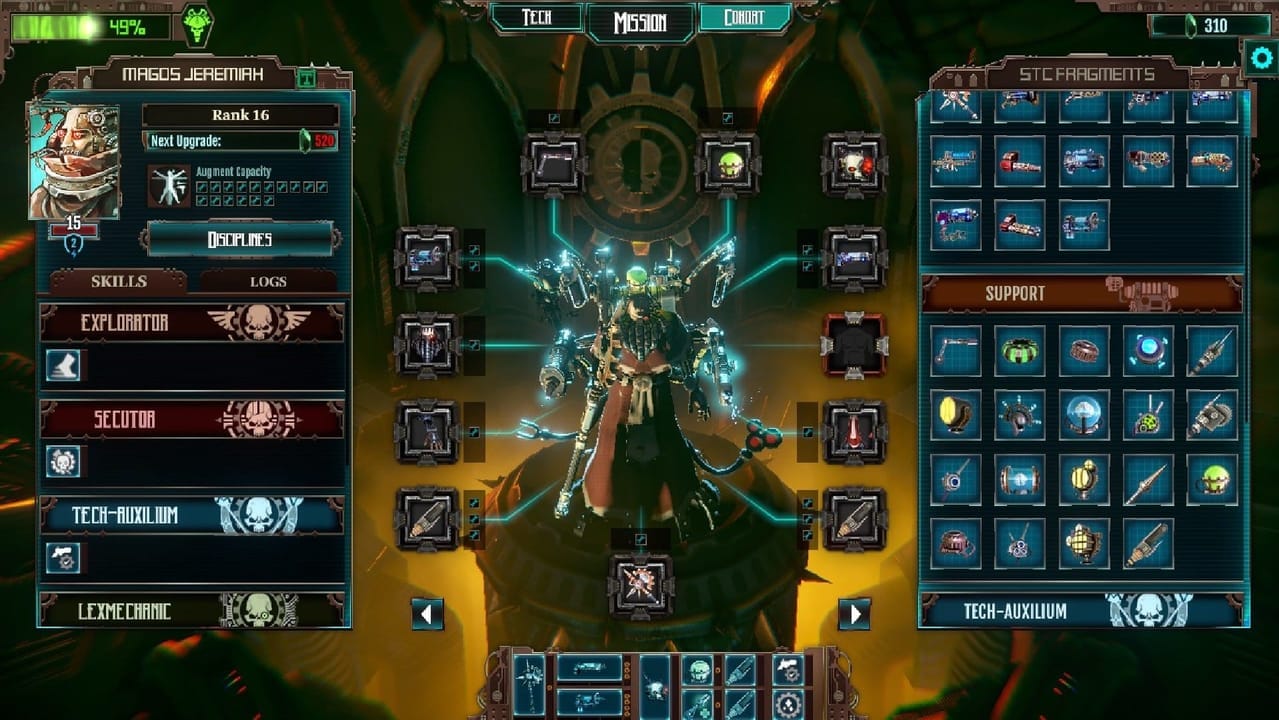
Think of your tech-priests as heroes. They’re upgradeable, and they have tons of health. Your goal is to make sure they get to the end of each mission. You also have expendable troops. These units cost a little blackstone to deploy and offer a variety of roles from cognition gatherers to crowd control and snipers. Troops stay in reserve until needed and can teleport into battle at the cost of cognition points proportional to their value. Each is designed to fill a role, but I’ll admit I never used them after the first few missions. That’s because Mechanicus has a steep learning curve, but difficulty hits freefall once you unlock AoE and penetrating weapons
At one point I fought a Necron boss wearing a human skin cape, standing at the top of a spiraling tower of corpses. On the first turn of the first round, my spider-legged tech-priest activated a buff that grants additional movement and damage until the next attack. Then he burned two cognition points to run all the way up the tower. He activated an ability giving all his weapons the “Machine Spirit” bonus. My tech-priest fired his two plasma beams, ran up to the boss and slapped him. CRITICAL HIT! The boss’ body rag dolled off the tower, disappearing into the misty abyss. The weird thing is, I didn’t feel bored. I felt accomplished that I had cheesed character creation so badly that something like this was even possible.
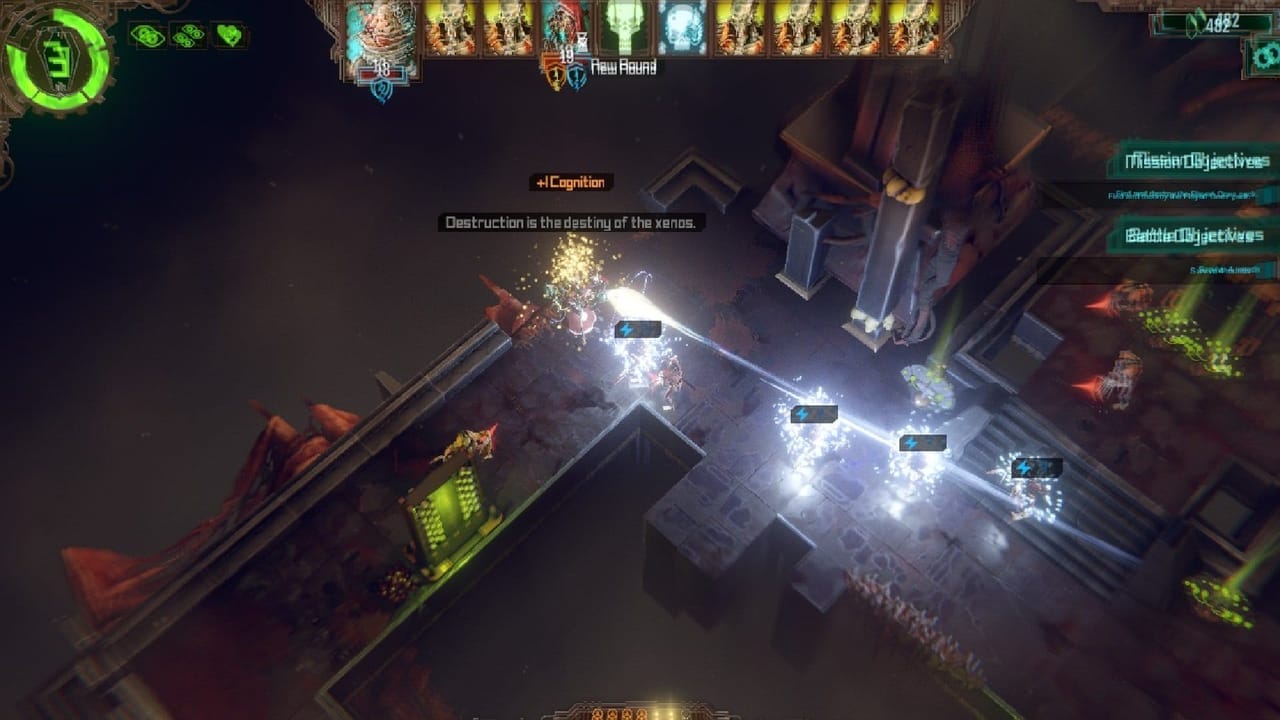
While the combat is excellent, the in-between is essentially a coin flip. Before you can get to the fighting, you must navigate a dungeon. This is mostly filler as objective locations highlight at the beginning. There’s no navigation puzzle. Every room is either a combat encounter, a fluff encounter, or a glyph. Glyphs are optional. You get 2-4 Necron symbols. One will give you a small bonus. The others will hurt you.
Fluff encounters are mandatory. A quest-related multiple-choice question appears. There are three options. Generally, one will hurt you, one will buff you, and one will do both. There’s no logic in how these events work. Sometimes the altar of human body parts is a trap. In another mission, examining the altar recovers lost cybernetic augments. It doesn’t feel fair.
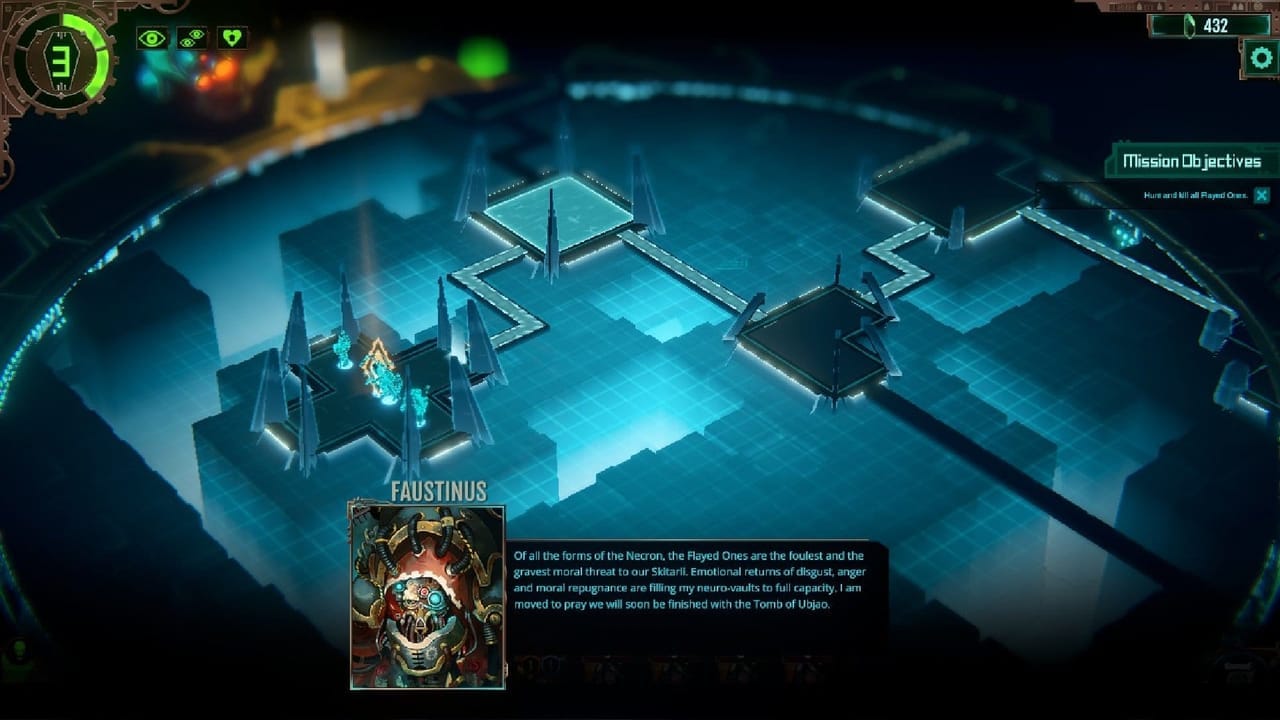
On the other hand, fluff encounters open the door for character encounters. As commander of this expedition, you have a handful of advisors, each of which embodies one of the tenants of the machine cult. This results in exact opposites butting heads, Spock/McCoy style, while Magos Faustinus (whose cybernetics allow him to block emotions) has to make the ultimate decision. For example, one of your advisors (who speaks in programming code) obsesses with collecting alien lore and technology. She is in direct opposition to your spiritual advisor who wants you to fight the Necrons with strategically-placed incense and binary prayer.
These interactions are a lot of fun to read. They also help to flesh out the dungeon-crawling sections between combat which could otherwise be dull. While Warhammer 40k games are famous for their voice acting, tech-priests don’t speak English. Instead, tech-priests speak Lingua-Technis, a language of focused static that sounds like electronic gobbledygook. Aside from being lore-friendly, this move makes a lot of sense because I’d rather hear the Lingua-Technis than have voice actors stumble through reading code aloud. That’s not to say there’s no voice acting at all; the Necron bosses relentlessly taunt you in plain English.
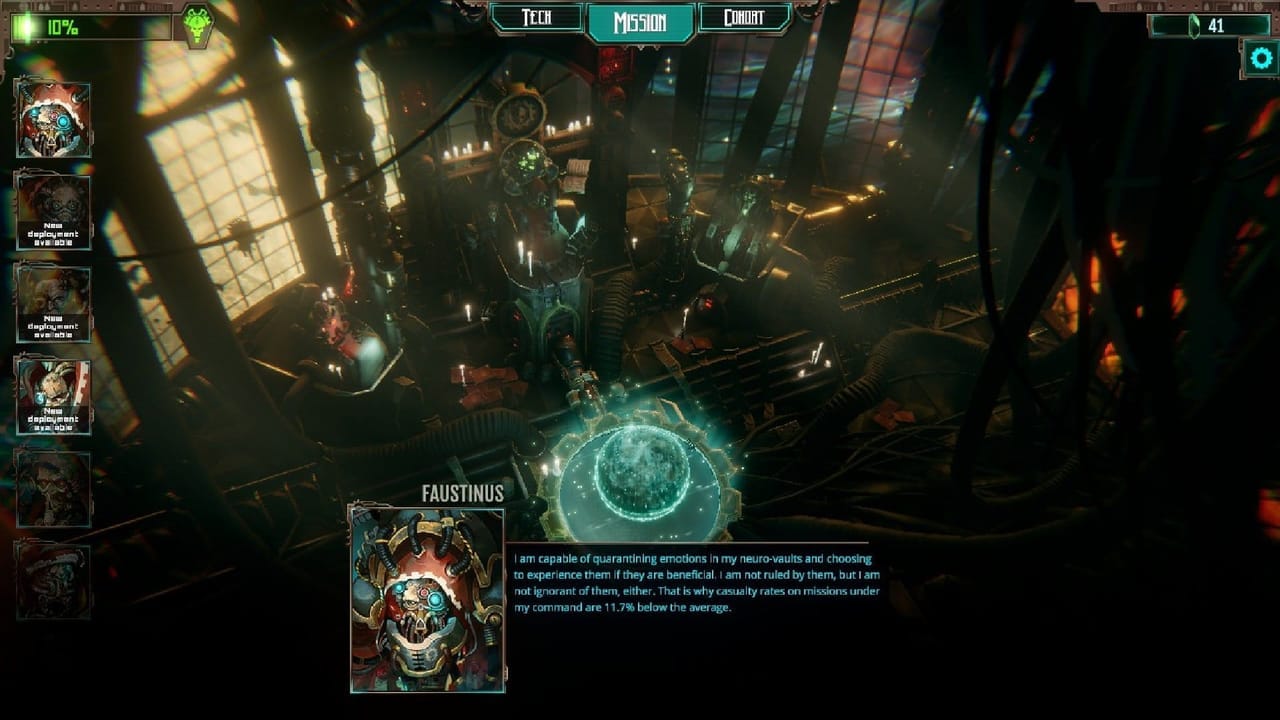
Mechanicus is almost a novelty. It features two underappreciated factions of the Warhammer 40,000 universe in a turn-based dungeon-crawling RPG setting. But the amazing thing is, it works. All the risks come together to make for a memorable, exciting, and strategic adventure. The combat is interesting. The character writing is simply incredible. While there are a few stumbling blocks in the dungeon-crawling, Mechanicus may be my favorite indie game of the year.
Praise the Omnissiah!
TechRaptor reviewed Warhammer 40,000: Mechanicus on PC via Steam with a copy provided by the developer.
Review Summary
Warhammer 40,000: Mechanicus redeems a long line of mediocre 40k games. As a turn-based combat RPG, it works on every level. The effect is only enhanced by excellent writing and incredible attention to detail.
(Review Policy)Pros
- Unique Turn-Based System
- Extremely Satisfying Combat
- Perfect Character Writing
- Strong Character Customization
Cons
- Coin Flip Encounters
- Very Easy
- UI Could Be Better
Have a tip, or want to point out something we missed? Leave a Comment or e-mail us at tips@techraptor.net
